Note: If an image ever fails to appear - refresh your page, it really is there
Flags of Britain and the United Kingdom - Page 2
Historical Flags 1800 to 1900
| Page #1 (c800-1800) | Page #2 (1800-1900) | Page #3 (1900-present) | English County Flags |
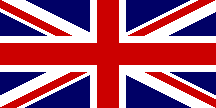
Union Jack 1801 |
The British Union Flag (Union Jack) since 1801
In 1801, the Cross of St. Patrick was added to the flag when Ireland joined the Union. This cross was placed with the Cross of St. Andrew. While Ireland's south broke away from the Union in 1921, the flag remains the same. The 1801 Union Flag, popularly known as the Union Jack, was introduced by Royal Proclamation, as a royal banner to be "displayed on all His Majesty's Forts and Castles, and also on board all His Majesty's Ships of War."
No law has ever been passed making the Union Flag the national flag of the United Kingdom: it has become one through usage. The Union Jack may have began as a royal standard, but is today recognized as the "de facto" national flag of the United Kingdom by all its citizens.
(Get More Information - Click Here)
|
Cross of Saint George
+
Cross of Saint Andrew
+
Cross of Saint Patrick
When Ireland was added notice how the white cross of Saint Andrew and red cross of Saint Patrick were combined. Saint Andrew's Cross is the one on top on the left side because he was the "senior" saint.
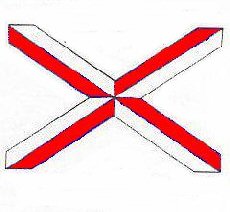
When two crosses are joined like this, they have been "counterchanged." |
The Making of the Union Jack
|
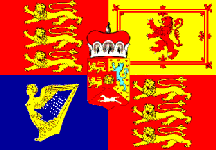
UK Royal Standard 1801
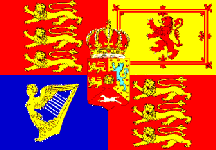
UK Royal Standard 1815
|
The Royal Standard of the United Kingdom 1801-1837
In 1801, the Act of Union united the Kingdoms of Great Britain and Ireland and King George III dropped the ancient claim to the French throne. The new royal standard was quartered with the English Royal Crest (crowned Lion Passant Guardant on a Royal Crown) in the 1st and 4th quarter, the Royal Standard of Scotland in the 2nd quarter and the Irish harp in the 3rd quarter. For the Electorate of Hanover, there was an shield with a Elector's hat above it added in the center.
A small change was made to the royal arms in 1815 when the Elector's cap above the shield of Hanover was replaced by a King's crown (as shown).
The final Hanoverian standard of 1815-1837 went out of use, as stated, because the Salic Law in Hanover prevented a woman from acceding to the throne. Thus, when Queen Victoria took the throne in 1837, she was not Queen of Hanover, but an uncle of hers took the title. The last public showing of this standard was at the funeral of William IV in 1837. That standard is preserved in the museum in Shrewsbury, because it was carried in the funeral procession by the then Lord Lieutenant of Shropshire (of which Shrewsbury is the county town).
( Click Here ) for a detailed look at the more than 40 British Royal Family Standards since 1801
|
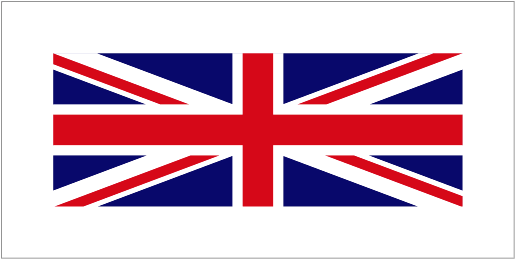
UK "Civil" Jack
(un-official)
|
United Kingdom "Civil Jack" 1823
The so-called "Pilot Jack," sometimes called the United Kingdom's Civil Jack, was originally formally established in 1823 as a signal flag to indicate that a pilot was required, and needed on-board a ship in harbor. Pilots are often required in restricted waterways where there are congested waters or navigational hazards such as harbors or river mouths. Since the law establishing it did not stipulate that it could not be also flown at sea, the convention started for merchant ships to use the jack at sea when under way as a sort of unofficial national flag.
The Admiralty and Board of Trade did not interfere with this illegal practice by merchant ships because they favored its use over that of the Union Jack by non-military ships. In 1970, the white-bordered Union Jack ceased to be the signal for a pilot, but references to it as national colours have not been removed from the current Merchant Shipping Act. It thus became a flag that could legally be flown on a civil ship, as a jack, if desired. |
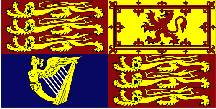
UK Royal Standard 1837
(England, Wales, and Northern Ireland)
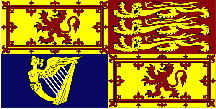
UK Royal Standard 1837
(used only in Scotland by tradition)
|
The Royal Standard of the United Kingdom since 1837
The accession of Queen Victoria ended the personal union between the United Kingdom and Hanover and the center shield and crown were removed. The flag was quartered with the English Royal Crest (crowned Lion Passant Guardant on a Royal Crown) in the 1st and 4th quarter, the Royal Standard of Scotland in the 2nd quarter and the Irish harp in the 3rd quarter. The Harp of the Kingdom of Ireland remained the same despite Ireland splitting into the Northern Ireland and the Republic of Ireland in 1921. Wales doesn't get the 4th quarter because Wales is considered a principality, not a kingdom (much to the frustration of some Welsh patriots). This coat-of-arms has remained unchanged since 1837.
This is the flag flown by Queen Elizabeth in the United Kingdom today, and in foreign countries which are not members of the Commonwealth.
The Scottish version of the Royal Standard - since 1837
This is the Royal Standard of Scotland, which is part of the United Kingdom, but uses a slightly different royal standard. It is almost identical to the United Kingdom Royal Standard, except the Scottish Royal Arms takes place of honor in the first and fourth quarters. Since the time that James VI of Scotland united England and Scotland as James I, the royal families have kept two different versions of the royal standard, one giving Scotland the place of honor and one giving England the place of honor.
( Click Here ) for a detailed look at the more than 40 British Royal Family Standards since 1801
|
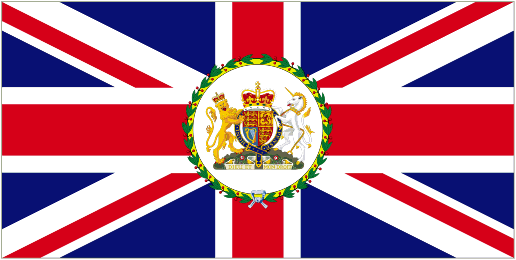
Ambassador's Flag
(or other Diplomatic Officer)
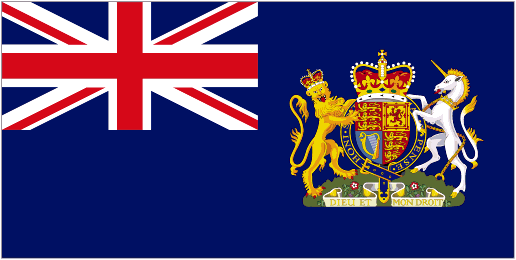
Consular Officer Afloat
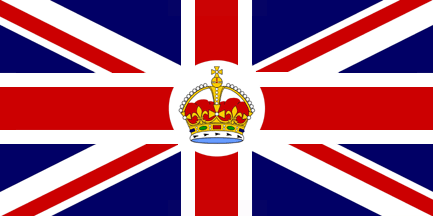
Tudor Crown version
|
United Kingdom Diplomatic and Consular Flags 1869
In 1869, governors of colonies, military authorities, diplomatic officers and consular agents were first assigned a defaced Union Jack for their use when they sailed on a sea going vessel, but on land it remained a plain Union Jack. In 1940, this was changed, so that the defaced ensigns were approved for use at Government Houses from sunrise to sunset. The flags were official describe as an "Union Flag with approved arms or badge of the colony, emblazoned in the centre thereof on a white ground surrounded by a green garland."
|
|
|
St. Edwards Crown version (1953-1999) |
|
St. Edwards Crown version (after 1999) |
The crown used at the center of the Consular Officer flag has been changed twice from the original Tudor Crown. First, in 1953 it was changed to a St. Edwards Crown, then in 1999, the St. Edwards Crown was re-drawn with the white circle being outlined in black. Since 1869, the British Consular Flag Afloat has been the royal arms applied directly (no white disc as used for diplomatic officers on the Union Flag) to the field of a Blue Ensign and remains unchanged. |
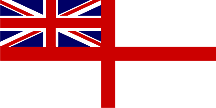
UK Royal Navy Ensign

UK Merchant Ensign
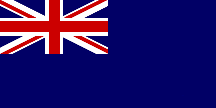
UK Naval Reserve Ensign
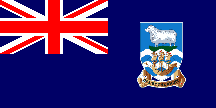
Falkland Islands Ensign
An example of an ensign with a shield added to the fly
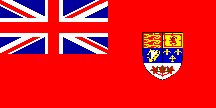
Canadian Red Ensign 1957-65
An example of an obsolute ensign
with a shield added to the fly
|
United Kingdom Naval Ensigns - since 1864
The Royal Navy had, since the late 1620s/early 1630s, been organized into three squadrons, which flew either red, white or blue ensigns with a Saint George's cross canton. In 1707, a Union canton replaced the Saint George's canton on the ensigns, and the Red Ensign remained not only the ensign of the senior and most numerous squadron in the Royal Navy, but also the ensign which all merchant ships were ordered to fly. The British still use three basic maritime ensigns today. However, the practice of adding shields to the flies for overseas territories and Commonwealth member nations to the red or blue versions increases the possible versions. The ensigns are/were used not only for territories, but also government departments and some yacht clubs. Currently there are over 133 defaced ensigns in use, plus an additional 68 being used for yacht clubs. Add to this another 99 obsolete ensigns from the British Isles, 52 additional obsolete yacht clubs, and 303 obsolete ensigns from the Commonwealth and the Empire, and you have a staggering number of defaced ensigns now or once being used.
The Royal Naval Ensign 1864The White Ensign became the sole ensign of the Royal Navy in 1864. In 1702 an overall St George's cross was added to the white ensign to distinguish it from the French flag, which was mainly white. Nelson used the White Ensign at Trafalgar; it replaced the traditional Red Ensign which became the merchant ensign. Nelson's decision that all the squadrons at Trafalgar should use the White Ensign was probably a factor in its selection as the sole ensign of the Royal Navy, but more importantly, the Red Ensign had been the ensign of merchant ships for over one hundred and fifty years, and the White Ensign was senior to the Blue Ensign.
The British Merchant Navy Ensign 1864The Red Ensign is now solely the ensign of ships of the British Merchant Navy and of all civilian vessels that have not been granted a special ensign. The British Merchant Navy connotes British merchant ships and their crews, transporting cargo and people during time of peace and war. Interestingly, the Red Ensign was the first flag to be recognized officially as the national flag of England. It was referred to as "a national flag" in an Act of Parliament in 1854. The Red Ensign is now officially the national flag of the UK when afloat.
The Royal Naval Reserve Ensign 1864The Blue Ensign became the Royal Naval Reserve Ensign. The Royal Naval Reserve (RNR) is the volunteer reserve force of the Royal Navy (RN) in the United Kingdom. The Blue Ensign is also flown by merchant vessels commanded by officers in the RNR. For this reason, the Titanic wore the Blue Ensign, rather than the Red on her fateful voyage.
This is a widely misunderstood ensign. It is not some form of military ensign as its name suggests, but an ensign granted to merchant ships and yachts by special warrant. The members of some yacht clubs had been granted the right to fly a Blue Ensign instead of a Red Ensign even before 1864. After 1864 the right to fly a Blue Ensign was extended to merchant ships that were commanded by an RNR officer and had a specified number of RNR personnel in the crew. The number of merchant ships that qualified has declined considerably, and it is probable that there are now no merchant ships flying a Blue Ensign. However there are thirty yacht clubs, Australian as well as British, that have the right to apply for a Blue Ensign warrant. (An example has been included directly below as the Army Sailing Association Blue Ensign.)
|
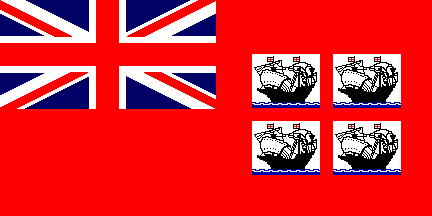
Trinty House Ensign

Trinty House Jack
|
Trinty House c1864
Trinity House (1514) is the general lighthouse authority for England, Wales, Channel Islands and Gibraltar, and responsible for pilotage throughout the United Kingdom. Until 1864 vessels in the service of certain United Kingdom public offices used defaced the red ensign with the badge of their office. In that year they were directed to transfer the badge to a blue ensign. For some reason Trinity House didn't do it and still have their badge of four Elizabethan ships quartered on a rectangular panel on a red ensign.
|
|
|
Master of Trinity House |
|
Deputy-Master of Trinity House |
Both the master and deputy-master of Trinity House have their own flags separate from the jack. The master's flag consists of a Cross of Saint George on a white field with an antique ship in each canton and a coat-of-arms in the center. The Deputy Master's flag replaces the coat-of-arms with a lion in a roundel. His Royal Highness the Duke of Edinburgh holds the honorary rank of Commander. The actual Chief Executive Officer of Trinity House is the Deputy-Master. |
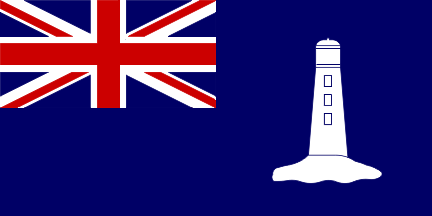
NLH Ensign 1855
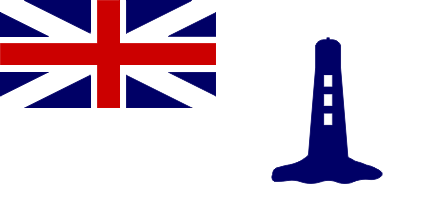
NLH Commissioner's Flag 1855
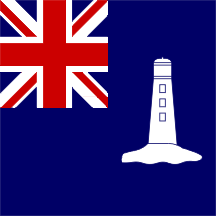
NLH Jack 1855
|
Northern Lighthouse Board (Northern Lights) 1786
The Northern Lights is the general lighthouse authority in Scotland and the Isle of Man. The NLH ensign is a normal blue ensign with a white stylized lighthouse on the fly.
|
|
|
NLH Ensign 1786 |
|
NLH Commissioner's Flag 1786 |
The more slender lighthouse on the older versions of the NLH flag are of the lighthouse on Bell Rock in Scotland.
|
|
|
NLH Pennant 1786 |
|
NLH Pennant 1855 |
A square version of their blue ensign (both 1786 and 1855 styles) was authorized for use by Northern Lighthouse vessels as a jack.
 Dare we say, "Long may it wave?" A whole series of variant lighthouse drawings on NLH ensigns have been reported at various times as demonstrated on this whimsical elongated illustration by vexillologist Peter Hans van den Muijzenberg.
|
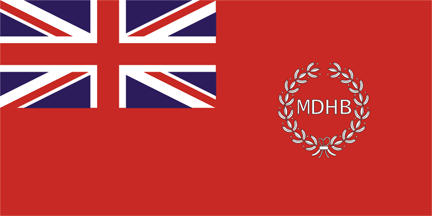
MDHB Red Ensign c1880-1912
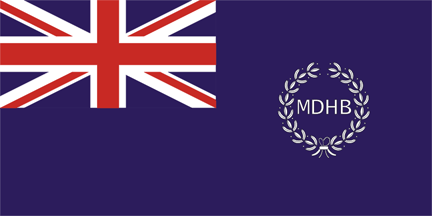
MDHB Blue Ensign 1912-present
|
Mersey Docks and Harbour Board (MDHB) Ensigns since c1880
The Mersey Docks and Harbour Company (MDHC), formerly the Mersey Docks and Harbour Board (MDHB), now owns and administers the dock facilities of the Port of Liverpool, on the River Mersey, England. The Liverpool Town Council was the original port authority. As the port expanded and its management became more complex its affairs were delegated to a harbor board whose chairperson was usually a Royal Navy Officer.
The Mersey Docks & Harbour Board ensign was changed from Red to Blue in 1912. It has been suggested that the change had something to do with the appointment of Vice-Admiral Prince Louis of Battenberg, Commander-in-Chief of the Atlantic Fleet, to the position of Second Sea Lord in 1911. The new Blue Ensign was first hoisted on a ship named Prince Louis of Battenberg.
In 1972, the need for a new public body to run the harbor was a result of pressure from Parliament, dock merchants and some rival port operators. The Board was reconstituted as a company to allow it to raise money for new building initiatives and projects. The Blue Ensign is current. The badge has not been changed and is still MDHB. |
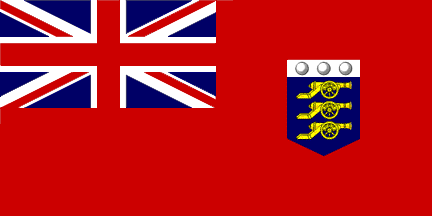
Ordnance Ensign
|
Board of Ordnance Ensign 1801-1855
The Board of Ordnance was originally created by Henry VIII in 1544 to supply guns, ammunition, stores and equipment to the King's Navy. The Great Master of Ordnance ranked immediately below the Lord High Admiral. By 1683, the Board had became a Civil Department of State, under a Master General, whose duties included supplying ordnance to the Army. It had a badge bearing three field guns in pale, and three cannon balls in chief was adopted as the Seal of the Board. This seal was used as the badge on the Red Jack of all Ordnance Board vessels. |
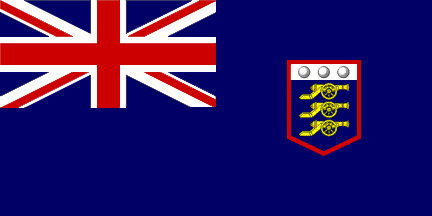
War Department Ensign
|
War Department Ensign 1864-1890
The War Department was the United Kingdom government department responsible for the supply of equipment to the armed forces of the United Kingdom and the pursuance of military activity. In 1857, it became the War Office. Within the War Office the name "War Department" remained in use to describe the military transport services of the War Department Fleet and the War Department Railways.
In 1794, the position of Secretary of State for War was created. The Secretary's department was at first only unofficially called the War Department. In 1855, the offices of the Secretary of State for War, and Secretary at War were merged and the new department became the War Department and as mentioned above, in 1857 became the War Office. In 1964, the department became the Ministry of Defence. |
- My thanks to David Prothero and Michael Faul for their invaluable help on this page -
| Page #1 (1189-1800) | Page #2 (1800-1900) | Page #3 (1900-present) | English County Flags |
|